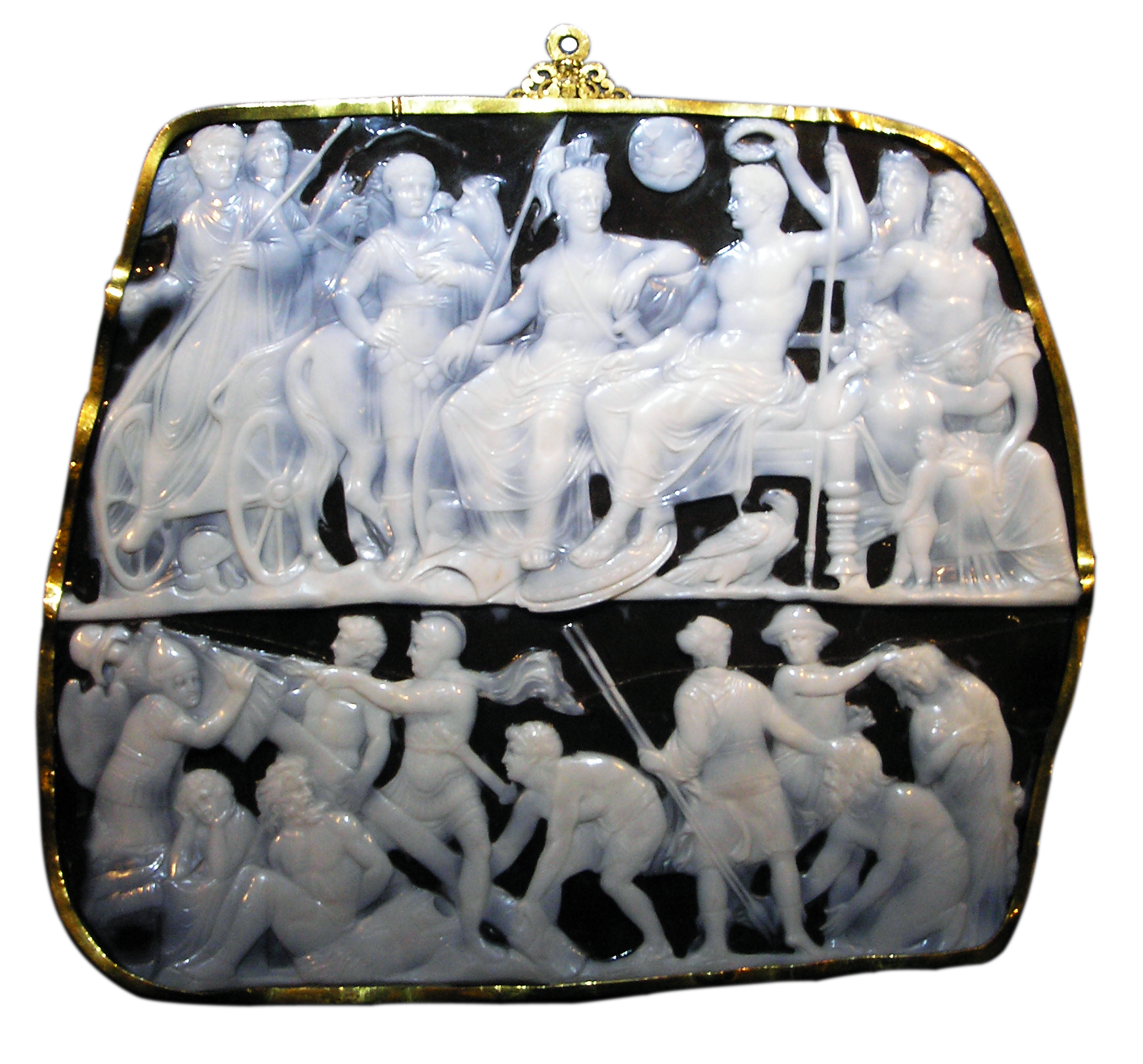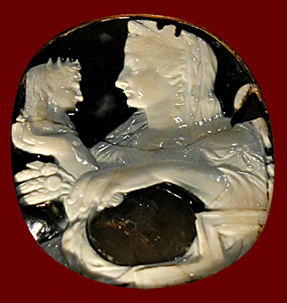When and why did cameos fall out of style? I still have a couple in my jewelry box, and I find them beautiful, just that they scream “crazy old lady with ten cats and a persistent scent of moth repellent”. Ah, well. The ancients knew better, as usual, and the ancient Roman cameos were great works of miniature sculpture, valuable pieces of jewelry and means of imperial propaganda. A lot of meaning in such a small gem.
So, what on Earth is a cameo anyway? It's an engraved gem, or a piece of jewelry that contains a relief image on a negative background, called intaglio. Pretty intricate pieces of work, as you can see from the ancient Roman cameo below, which displays their famous eagle carved in onyx, on two layers, to obtain the contrasting color effect.
Augustus in particular, and the entire Julio-Claudian dynasty in general, enjoyed these minor sculptures and commissioned a lot of them – and, fortunately, some survived to this day, after being integrated into various pieces from the Middle Ages.
Ancient Roman cameos were made mostly of semi-precious stones, such as agate, onyx and sardonyx, and are known today as “hardstone cameos”. The Romans also created glass cameos, made of a colored base layer, which was then dipped into white glass, and the ensemble was blown together to create the final piece.
Most of the ancient Roman glass cameos were broken in time, and the most famous piece that survived to this day is actually a vase. Known as the Portland Vase, it's currently on display in the British Museum, and worth mentioning as a fine example of the technique described above.
The Great Cameo of France
Grand Camée de France is the largest of the ancient Roman cameos that has survived. It's 26 cm wide and 30 cm tall, which means that it's safe to assume it was never used as a piece of jewelry, and it was probably displayed as a small sculpture or work of art in its own right.
It's made of five layers of sardonyx, and it was first attested in the inventory of Sainte Chapelle, in Paris, in 1279. The piece itself was created around 20 AD, though we cannot be certain of the date. As it was heavily modified both in ancient and in medieval times, there's a lot of speculation about the characters depicted. The most commonly accepted interpretation today is that the central figure is Emperor Tiberius, accompanied by his mother Livia and his designated heir at the time, Nero Drusus.
In the upper level, we have the dead ancestors, Augustus himself, Drusus II and Germanicus, and in the lower levels, captive barbarians or symbols of conquered peoples. Truth is, the cameo may well depict any of the Julio-Claudian emperors receiving one of their successful generals. Normally there should be enough detail in the lower level of the cameo to identify the nation conquered, and thus the time and the general in question, but here it's not the case.
Gemma Augustea
Gemma Augustea is clearly the most famous of the ancient Roman cameos. It's made of Arabian onyx, and it's commonly believed that we can identify the artist who made it, either a rather famous one named Dioscurides or one of his apprentices. Either way, the work was clearly done in the first half of the first century AD.
The central figure, on the throne, is generally accepted as being Augustus. He is represented as a god, and we know that Augustus was not deified during his life; so this work was either commissioned after this death, or by him, as a work of propaganda to be sent as a gift to a ruler from the Eastern provinces (deification was not ok within the Italic peninsula; in other parts of the Empire, Augustus and his heirs had no problem presenting themselves as living gods).
Other identifiable images are the goddess Roma, the helmeted figure sitting next to Augustus, and Oikumene, the goddess of the entire inhabited world, behind Augustus, crowning him. There has been some discussion that Roma resembles Livia, Augustus' wife. Also notice the eagle under the throne, symbol of Jupiter. That's what's so neat about these ancient Roman cameos, they are so rich in symbols, you can spend days trying to figure out what's shown on these tiny carvings – and some scholars actually do that for a living.
Gemma Claudia
My personal favorite, Gemma Claudia, same as Gemma Augustea, can be found today in the Kunsthistoriches Museum in Vienna.
It was probably done to celebrate the controversial marriage of Emperor Claudius to his niece, Agrippina (both of them are shown on the left side). On the right side, the cameo shows Agrippina's parents, Germanicus and (duh) Agrippina.
The propagandist aim of the cameo was to stress Agrippina's illustrious family (as if anybody in Rome would've forgotten that) and to imply that Germanicus, one-time heir to the imperial throne and a favorite of the Roman mob and army, would have approved of his daughter's marriage. (Germanicus was long dead at the time, most unfortunate for the Romans themselves, who insisted on having his heirs on the throne, with the worst possible results).
Propaganda aside, the artist did a wonderful job on this ancient Roman cameo: there are no less than five alternate layers, but the material still has a wonderful transparency effect because they are incredibly thin, only 2 mm in some places.
Other ancient Roman cameos
The Blacas Cameo, cut in three layers of sardonyx, shows another majestic image of Augustus, and was probably part of the larger piece. As in all such works, the headband was added later, as it was a symbol of Hellenistic royalty – and Augustus himself would not have made such a mistake in his days.
There's also a well-known cameo featuring Messalina, one of the many poor choices made by Emperor Claudius in marriage. The two children are, of course, Octavia and Britannicus, to underline Messalina's image as mother of the future emperor. Not only she didn't make it that far, but both children were assassinated by Nero (being part of the royal family was tons of fun, but also very dangerous).
The last example also comes from Vienna (in case you didn't get it until now, let me spell it out for you: the Kunsthistoriches Museum in Vienna has the best collection of ancient Roman cameos in the world. Go check it out.) Not as beautiful as the rest, but still a nice piece of imperial propaganda, showing Livia, a ruthless and effective politician in her own right, with a bust of Augustus.












